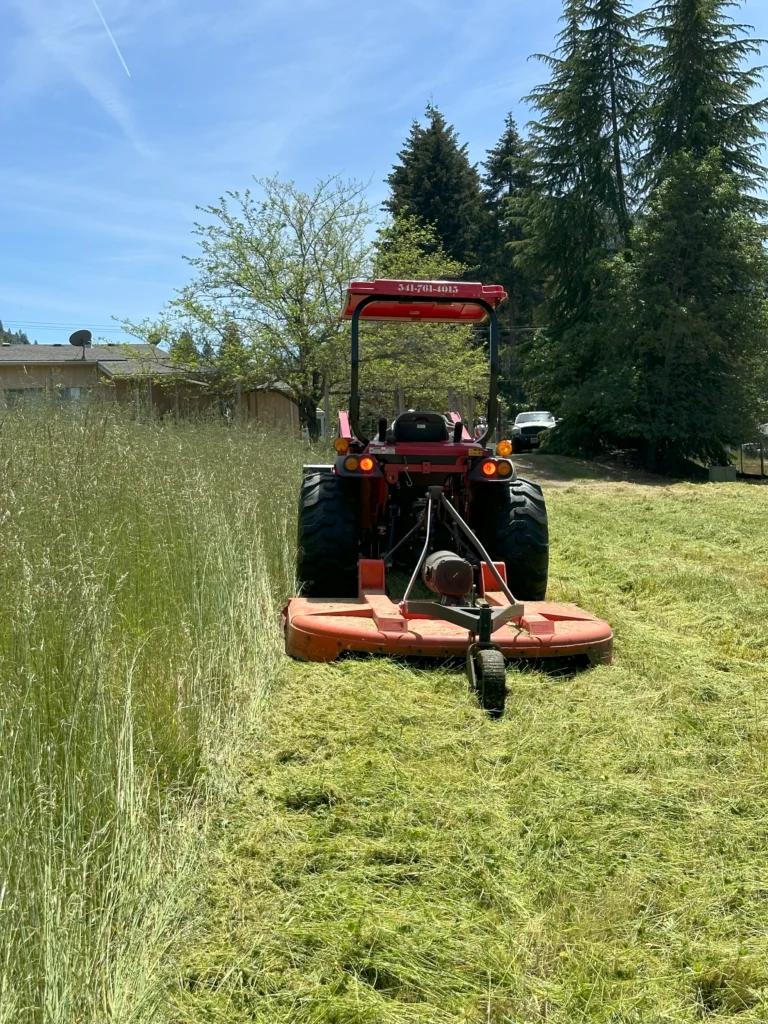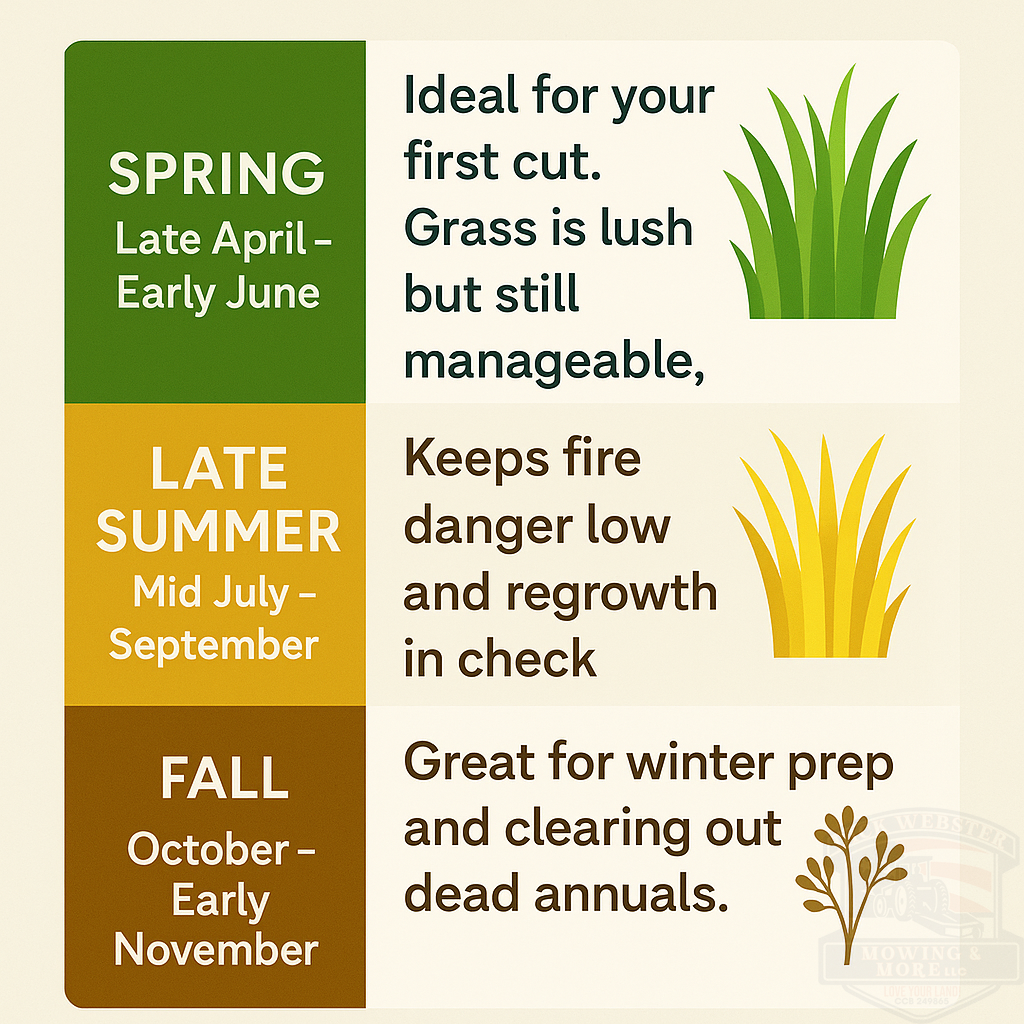Taming the Spring Surge: Why Field Cutting Isn’t Just a “Nice-to-Have”
Every year, like clockwork, the fields across Southern Oregon decide to shoot up like they’ve had three shots of espresso. One day you’re admiring your open space and the next, it’s a full-on jungle threatening to swallow your tractor whole. That’s where field cutting in the Rogue Valley earns its keep.
In places like Grants Pass, Ashland, and out along the winding stretches of Cave Junction, spring growth isn’t just fast—it’s relentless. Managing that growth isn’t about keeping your property pretty (although it certainly helps). It’s about fire safety, property access, and long-term land health.
Field cutting is more than just running a mower through tall grass. It’s strategic. It’s seasonal. And when done right, it can be one of the best investments you make for your land all year.

Creating Defensible Space in Fire Country
In Southern Oregon, wildfire season is as much a part of life as blackberry brambles and roadside deer. That’s why defensible space isn’t just a buzzword—it’s a line of defense.
Strategically cutting back vegetation around homes, barns, driveways, and outbuildings can slow or even stop the progress of a wildfire. While no method is foolproof, properly timed field cutting drastically reduces fuel load, gives fire crews room to work, and gives your home a fighting chance.
If you’re wondering “how often should I cut my field?”, the short answer is: at least twice a year, and more if spring rains keep coming. Cutting in late spring curbs fast growth. A follow-up in mid to late summer keeps regrowth under control before the fire danger peaks.
Is Field Cutting In The Rogue Valley Safe for the Environment?
Short answer: yes—when done right.
Southern Oregon is home to delicate ecosystems, but unmanaged fields can cause more harm than good. Overgrown areas become breeding grounds for invasive species that overtake native grasses and plants. Star thistle, for example, spreads fast and creates dense mats that crowd out more beneficial vegetation.
When field cutting in the Rogue Valley is done with clean-burning equipment like Tier 4 diesel engines, the environmental footprint stays small. Professional operators also take care not to spread seeds or disturb wildlife unnecessarily, making the entire process a net positive for the land. Responsible mowing helps prevent erosion, supports healthier soil, and can even encourage native plant recovery when timed right.
The Practical Benefits: More Than Just Curb Appeal
Let’s be honest—neatly cut fields look good. But the real benefits go deeper than aesthetics. A well-maintained field makes it easier for you, your family, or utility crews to access your land. Overgrown grass and brush can block trails, hide hazards, and make even simple tasks a chore.
Keeping fields cut also discourages unwanted pests from making themselves at home. Ticks, snakes, and rodents thrive in tall, unmanaged grass. Field mowing reduces their habitat, which in turn helps protect pets, livestock, and people.
From a safety standpoint, mowed fields reduce fire fuel by limiting dry, flammable debris. That’s peace of mind, especially as Southern Oregon enters its dry summer stretch. And if you’re ever thinking about selling or leasing your property, a clean, maintained landscape adds instant appeal and market value.
What Does a Field Mower Actually Do?
A field mower is not your average ride-on lawnmower. These are heavy-duty machines designed to tackle everything from knee-high grass to stubborn brush and brambles. Whether it’s a flail mower, rotary cutter, or brush hog, each is equipped to power through tangled vegetation and uneven terrain without hesitation.
When handled by someone who knows the land, a field mower won’t just flatten the area—it revitalizes it. These machines cut vegetation cleanly, encourage regrowth at a manageable pace, and help keep soil structure intact. Unlike makeshift mowing jobs that leave the ground churned up or compacted, professional-grade field cutting is precise, even, and sustainable.

Timing Is Everything: Seasonal Field Cutting in the Rogue Valley
In Southern Oregon, timing your field cutting is a balancing act between moisture, growth, and fire season:
- Spring (Late April – Early June): Ideal for your first cut. Grass is lush but still manageable, and getting ahead of growth prevents massive overgrowth.
- Late Summer (Mid-July – September): Keeps fire danger low and regrowth in check.
- Fall (October): Great for prepping your property for winter and removing dead annuals.
Waiting too long can mean heavier equipment is required, which increases costs and the risk of damaging the soil—especially in softer areas around the Illinois Valley.
More Than Just Fields: Other Services That Support Healthy Land
While field cutting is the heart of seasonal land care, many properties benefit from additional work to stay functional and safe.
Blackberry removal is a common request in areas like Ashland and Medford. These fast-growing vines can choke out pastureland, block paths, and engulf fence lines in a single season. Mowing alone won’t cut it—removal requires specialized equipment and technique, but it’s well worth the investment when your property starts breathing again.
Fire reduction services go hand-in-hand with field cutting but often involve targeted removal of small brush, light trees, and ladder fuels. This creates a wider safety buffer around structures and roadways, something particularly important during Southern Oregon’s long dry season.
Grading and trench digging are crucial when it comes to erosion control and water flow. Poor drainage can wreck roads and cause pooling that leads to invasive weed growth. Adding a slope, trench, or swale in the right spot can make all the difference after a heavy rain.
Driveway repair is often overlooked, but for rural properties, it’s a necessity. Crumbling gravel roads or overgrown edges can block access, damage vehicles, and lower property value. Tidy driveways are not just functional—they’re a welcome mat to the rest of your land.
Pond bank and ditch cutting help maintain healthy waterways and prevent overflow. When vegetation gets too dense around water features, it can trap sediment and clog flow paths. Routine trimming keeps these areas clean, reduces mosquito breeding grounds, and promotes a healthier aquatic environment.
Your Land Deserves More Than a Quick Pass
When it comes to field cutting in Southern Oregon, timing, technique, and care all matter. Whether you’re in the Rogue Valley or tucked into the hills of Cave Junction, keeping your fields trimmed is an act of stewardship.
Letting your land go untamed doesn’t just cause headaches—it can create real risk. From fire danger to weed invasion, unmanaged fields make your property harder to use, harder to enjoy, and harder to protect. Cutting those fields is more than maintenance. It’s part of a larger strategy to care for your corner of Oregon.
And let’s face it—nobody wants their property to be that one with grass so tall it waves at passing planes.
Ready to Cut Back the Chaos?
If your property is in need of some seasonal attention, start with the basics. Visit the Field Cutting Services page to schedule a no-hassle consultation and get your land ready for whatever Southern Oregon throws at it.

